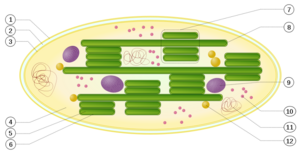CZ:Featured article/Current
Thylakoid

Schematic of a chloroplast: 1. outer membrane; 2. intermembrane space; 3. inner membrane (1+2+3: envelope); 4. [stroma (aqueous fluid); 5. thylakoid lumen (inside of thylakoid); 6. thylakoid membrane; 7. granum (stack of thylakoids); 8. thylakoid (lamella); 9. Starch; 10. Ribosome; 11. plastidial DNA; 12. plastoglobule (drop of lipids).
Inside plant cells and other eukaryotic cells that perform photosynthesis, tiny, bacteria-sized organelles, called chloroplasts, contain, within the inner membrane of their dual membrane structure, an extensive system of single-membrane-bound flattened sacs called thylakoids, their interior spaces (lumens) interconnected, their membranes housing the pigment molecules that absorb the energy of photons of particular frequencies emitted by the sun, an event that initiates the physico-chemical sequence of steps culminating in the products of photosynthesis.[1] A semifluid matrix within the chloroplasts, called the stroma, bathes the thylakoids. The flattened thylakoid sacs consist of clustered stacks, called grana, their lumens interconnected by extensions, called 'stromal thylakoids', or lamellae.[2] [See accompanying illustration at right.]
| notes |
|---|
|